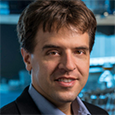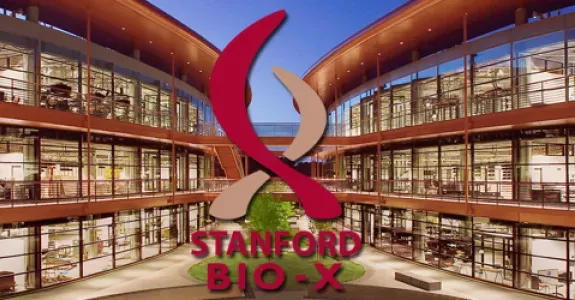
Welcome to the biweekly electronic newsletter from Stanford Bio-X for members of the Bio-X Corporate Forum. The following are key links to the history of Bio-X and the Clark Center (hub of Bio-X): Bio-X Timeline, CLARK CENTER @ 10X, and President John Hennessy's article calling Bio-X and the Clark Center "A Cauldron of Innovation".
Please contact Dr. Hanwei Li, the Bio-X Corporate Forum Liaison if you would like to be added or removed from this distribution list, or if you have any questions about Stanford Bio-X or Stanford University.
 KARL DEISSEROTH WINS $3M BREAKTHROUGH PRIZE!!
KARL DEISSEROTH WINS $3M BREAKTHROUGH PRIZE!!
Three Stanford professors were awarded prizes by the Breakthrough Prize Foundation during a star-studded award ceremony Sunday night. Karl Deisseroth, professor of bioengineering and of psychiatry and behavioral sciences at Stanford, won a $3 million 2016 Breakthrough Prize in life sciences for his contributions to the development of optogenetics, a technique that uses light to control the behavior of cells and has proved especially invaluable in the study of nerve-cell circuits in the brain. Two Stanford physicists were awarded New Horizons in Physics Prizes, each of which are paired with a $100,000 prize. Xiao-Liang Qi, an associate professor of physics was recognized for "outstanding contributions to condensed matter physics, especially involving the use of topology to understand new states of matter." Leonardo Senatore, an assistant professor of physics, was honored for his "outstanding contributions to theoretical cosmology."
Bio-X Core Programs
 SEED GRANTS FOR SUCCESS - Stanford Bio-X Interdisciplinary Initiatives Program (IIP) SEED GRANTS FOR SUCCESS - Stanford Bio-X Interdisciplinary Initiatives Program (IIP)The Bio-X Interdisciplinary Initiatives Program represents a key Stanford Initiative to address challenges in human health. Currently, the IIP is in its 7th round, and awards approximately $4 million every other year in the form of two-year grants averaging about $200,000 each. The first 6 rounds have resulted in a 10-fold-plus return on investment, hundreds of publications, dozens of patents filed, and most importantly, the acceleration of scientific discovery and innovation. In total, Bio-X has awarded 164 IIP Seed Grants, with the 22 newest ones selected just last year from 142 Letters of Intent (LOIs). |
 Bio-X FELLOWSHIPS Bio-X FELLOWSHIPSThe Bio-X Fellowships started in 2004, and are awarded every year to graduate students and postdoctoral scholars of Bio-X affiliated faculty whose projects are interdisciplinary and utilize the technologies of different fields to solve different biological questions. Our fellows have conducted exciting research, resulting in publications in high-impact journals and have been offered excellent positions in industry and academia. To date, Stanford Bio-X has a total of 198 Fellows. We announced the 25 new winners of the 2015 PhD Fellowship program during the Fellows Symposium on Oct 6, 2015. Click here to view the 198 Fellowship projects, and here for the oral presentations from previous symposiums. |
 Bio-X UNDERGRADUATE SUMMER RESEARCH PROGRAM Bio-X UNDERGRADUATE SUMMER RESEARCH PROGRAMThe Bio-X Undergraduate Summer Research Program (USRP) trains ambitious and stellar undergraduates by supporting interdisciplinary undergraduate summer research projects. The program is an invaluable opportunity for students to conduct hands-on research, learn how to carry out experiments in the laboratory, and develop the skills to read and analyze scientific literature. To date, 371 awards have been given to the Stanford undergraduate community in the past 11 years. The 2015 USRP had 65 students selected from nearly 170 applicants, and the program culminated in the poster presentation of the latest Bio-X IIP Seed Grant Symposium in August. Click here to read the various USRP projects, and here for Faculty Talks by participating hosting faculty members each summer. |
SYMPOSIUMS: Bio-X also holds symposiums every year that highlight our core programs, including the IIP Seed Grants Program Symposiums, the Fellows Symposiums, and the Annual Symposiums.
COLLABORATIONS: We are cultivating and are highly successful in building meaningful collaborations with numerous corporate colleagues. New collaborations through our core programs are highly encouraged. To learn about how to get involved, please contact Dr. Hanwei Li, or Dr. Heideh Fattaey.
News

 Measuring immune cells before surgery may help predict recovery time
Measuring immune cells before surgery may help predict recovery time
Bio-X Affiliated Faculty Martin Angst and Garry Nolan
Bio-X supported research, publication by Bio-X Bowes Fellow Gabriela Fragiadakis
The behavior of a type of white blood cell can indicate how soon patients will be back on their feet after hip surgery, according to a study by scientists at the Stanford University School of Medicine. The scientists plan to use the findings to develop a diagnostic blood test that patients can undergo before surgery. U.S. doctors performed more than 50 million surgeries, including some 300,000 hip surgeries, last year. While indicators for negative outcomes — like organ failure, infection and death — have been extensively studied, indicators for healthy recoveries have not. “Some people feel great after a few days, some are in bed for a month and we don’t know why,” said Gabriela Fragiadakis, a graduate student in microbiology and immunology. Fragiadakis shares lead authorship of the study, which was published online Nov. 17 in Anesthesiology, with Brice Gaudilliere, MD, PhD, clinical instructor of anesthesiology, perioperative and pain medicine. The senior authors are Martin Angst, MD, professor of anesthesiology, perioperative and pain medicine, and Garry Nolan, PhD, professor of microbiology and immunology. The study will also appear in the December issue of the journal.
 Story of family's tumor donation inspires more donations
Story of family's tumor donation inspires more donations
Bio-X Affiliated Faculty Michelle Monje
On her son’s first day as a brain tumor patient at Lucile Packard Children’s Hospital Stanford, Danah Jewett asked one of his doctors if her family could donate 5-year-old Dylan’s organs to other children when he died. Most organs from cancer patients can’t be transplanted, the pediatric neuro-oncologist, Michelle Monje, MD, PhD, explained. But the Jewetts could make an even bigger difference by giving Dylan’s tumor to Stanford for research, a donation with the potential to fill a gaping hole in the science of childhood cancer. Surprised, Dylan’s parents said yes. After Dylan’s death on Jan. 8, 2009, Monje and her colleagues transformed his tumor into the first cell culture of its type anywhere in the world. A few months later, a story in Stanford Medicine magazine about the Jewetts’ gift inspired more families to make similar donations, further boosting the research. Dylan had diffuse intrinsic pontine glioma, which grows in the brain stem region that controls breathing and heartbeat, tangling its cancerous cells with healthy cells “like a sweater knitted of multicolored yarn,” said Monje.
 Dangerous liaison: Bacteria, viruses in league
Dangerous liaison: Bacteria, viruses in league
Bio-X Affiliated Faculty Paul Bollyky
Scientists know a lot about bacteriophages, viruses that infect bacteria. Medical practitioners likewise understand the clinical dangers of biofilms: slimy, antibiotic-defying aggregates of bacteria and organic substances that can stick to the walls and inner linings of infected organs and to chronic wounds, making infections excruciatingly hard to eradicate. But any link between bacteriophages and biofilms was unsuspected. Now, in a series of experiments prompted by a chance discovery, Stanford University School of Medicine investigators and their colleagues at three other research institutes have shown that a bacteriophage, or phage for short, is critical to the formation of biofilms by Pseudomonas, a bacterial pathogen behind numerous hospital-acquired infections, pneumonia cases and cystic fibrosis fatalities. The experiments are described in a study published Nov. 11 in Cell Host & Microbe. The study, the first to show that a phage can drive the formation of bacterial biofilms, is also the first to implicate any type of phage in causing chronic infections. The study also explains why biofilms can resist certain antibiotics, a discovery that could yield entirely novel therapeutic interventions.

 New "tricorder" technology might be able to "hear" tumors growing
New "tricorder" technology might be able to "hear" tumors growing
Bio-X Affiliated Faculty Amin Arbabian and Pierre Khuri-Yakub
When Dr. Leonard "Bones" McCoy needs to diagnose an ill member of the Starship Enterprise, he simply points his tricorder device at their body and it identifies their malady without probing or prodding. Similarly, when Capt. Kirk beams down to an alien world, his tricorder quickly analyzes if the atmosphere is safe to breathe. Now Stanford electrical engineers have taken the latest step toward developing such a device through experiments detailed in Applied Physics Letters and presented at the International Ultrasonics Symposium in Taipei, Taiwan. The work, led by Assistant Professor Amin Arbabian and Research Professor Pierre Khuri-Yakub, grows out of research designed to detect buried plastic explosives, but the researchers said the technology could also provide a new way to detect early stage cancers. The careful manipulation of two scientific principles drives both the military and medical applications of the Stanford work. First, all materials expand and contract when stimulated with electromagnetic energy, such as light or microwaves. Second, this expansion and contraction produces ultrasound waves that travel to the surface and can be detected remotely.
Events
| Genetics November 18, 2015, 4 pm - 5 pm Clark Center Auditorium, Stanford, CA Frontiers in Biology - "Ribogenomic Medicine" Speaker: Robert Darnell, Rockefeller |
Stanford Neurosciences Institute November 19, 2015, 12 pm - 1 pm Clark Center Auditorium, Stanford, CA Seminar Series - "Sculpting Neuronal Connections: The Logic and Mechanisms of Axon Growth and Pruning" Speaker: Marc Tessier-Lavigne, President of Rockefeller University and Carson Family Professor |
Resources
| Stanford University |
| Stanford Bio-X |
| Bio-X Seed Grants The Stanford Bio-X Interdisciplinary Initiatives Program (IIP) provides seed funding for high-risk, high-reward, collaborative projects across the university, and have been highly successful in fostering transformative research. |
| Office of Technology and Licensing "Techfinder" Search the OTL Technology Portal to find technologies available for licensing from Stanford. |
| Stanford Center for Professional Development - Take advantage of your FREE membership! - Take online graduate courses in engineering, leadership and management, bioscience, and more. - Register for free webinars and seminars, and gets discounts on courses. |
| Stanford Biodesign Video Tutorials on how FDA approves medical devices A series of video briefs recently produced by the Stanford Biodesign Program teaches innovators how to get a medical device approved for use in the United States. This free, online library of 60 videos provides detailed information on the Food and Drug Administration regulatory process, short case studies and advice on interacting with the FDA. |
To learn more about Stanford Bio-X or Stanford University, please contact Dr. Hanwei Li, the Bio-X Corporate Forum Liaison, at 650-725-1523 or lhanwei1@stanford.edu, or Dr. Heideh Fattaey, the Executive Director of Bio-X Operations and Programs, at 650-799-1608 or hfattaey@stanford.edu.

